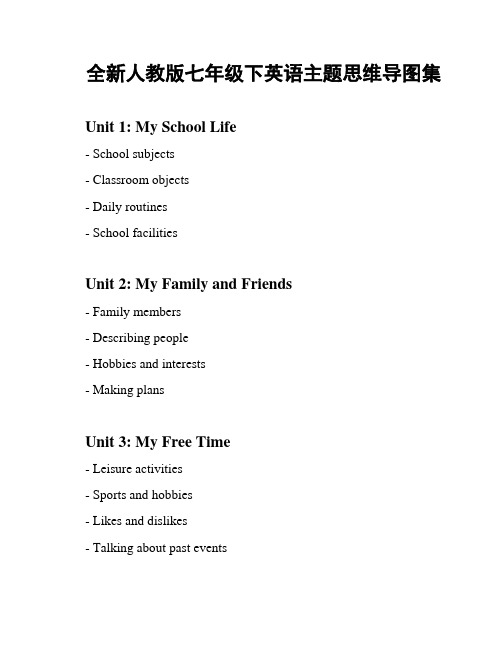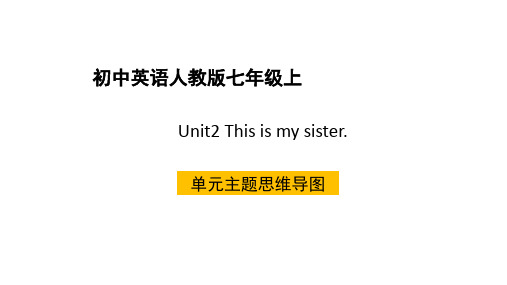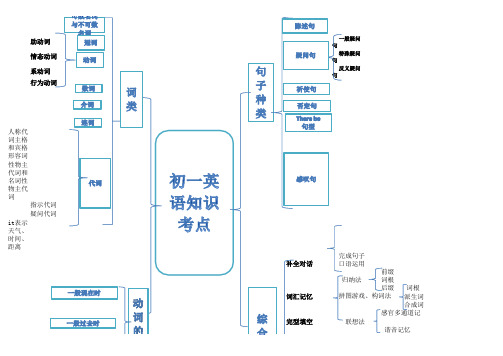初一英语思维导图
人教版七年级英语上册Unit7_单元主题思维导图

单元整体话题篇
the, this, that, these, those
one-nine, ten-thirty-one
yuan, dollar
Demonstratives
Prices
big → small, long → short
Sizes
Shopping
Structures
A: How much is this T-shirt? B: It's seven dollars. A: How much are those black trousers? B: They're nine dollars .
black, white, green, red, blue, yellow, purple, brown
Colors
Clothes items
T-shirt, sweater, skirt, hat, jacket, socks, shorts, shoes, trousers
语法篇
How much…? 句型
询问物品 价格
What’s the price this/that… +单数名词? How much are the/these/those…+复数名词?
e.g. What’s the price of the socks/the sweater?
功能对话篇
谈论颜色及大小
A: What color do you want? B: Blue. I like big purple hats. I like those long blue and yellow socks.
询问及提供帮助
A: Can I help you? B: Yes, please./I need…
人教版七年级下英语各单元主题思维导图

初中英语人教版七年级下
Unit2 What time do you go to school?
单元主题思维导图
Daily routines
日常作息习惯
对话篇 ng job Radio station What time…?
Scott:
12:00 —6:00
Interviewer: What time…get up?
Scott:
at 8:30
breakfast at 9:00
Interviewer: a funny time
Scott: Interviewer:
Scott:
exercise at 10:20
When do you go to work? 11:00/ never late for work
sports club
What…can you play?
soccer
join the soccer club
be good at tell story story telling club
like to draw
join two clubs
Let’s join now!
What can they do?
阅读篇 SectionB-2b
Place
The old people’s home The Student’s Sports Center
Requirements
Contact
Be free in July
Be _g_o__o_d_w__i_th__ old people
Can talk to them and play games with them
doesn’t like to get up early eating breakfast quickly having _h_a_m_b_u_r_g_e_r_s for lunch
全新人教版七年级下英语主题思维导图集

全新人教版七年级下英语主题思维导图集Unit 1: My School Life- School subjects- Classroom objects- Daily routines- School facilitiesUnit 2: My Family and Friends- Family members- Describing people- Hobbies and interests- Making plansUnit 3: My Free Time- Leisure activities- Sports and hobbies- Likes and dislikes- Talking about past eventsUnit 4: My Home- Rooms and furniture- Describing a house- Daily chores- Talking about future plansUnit 5: My City- Asking for ns- Places in the city- Modes of n- Giving ns about a cityUnit 6: My Daily Routine - Time and daily activities- Describing daily routines- Talking about habits- Expressing preferencesUnit 7: My Clothes- Clothing items- Colors and patterns- Describing outfits- Shopping for clothesUnit 8: My Food- Food and drinks- Describing tastes- Ordering food in a restaurant - Talking about food preferencesUnit 9: My Health- Parts of the body- Describing ailments- Giving advice- Talking about healthy habitsUnit 10: My Holidays- Holiday activities- Talking about past ns- Making travel plans- Describing a dream holiday以上是《全新人教版七年级下英语》的主题思维导图集,帮助学生系统地了解和掌握每个单元的主题内容。
新目标人教版七年级上册英语Unit2-单元主题思维导图(5张PPT)-(共5张PPT)

these, those 表复数,指th时is间, t或ha空t表间单数;
上较远的人或事
口诀助记
语法篇-指示代词
this
指代可数名词单数
This is Jenny. 这是珍妮。
these
指代可数名词复数
These are my parents. 那是我的父母。
that
指代可数名词单数 That is my father.
那是我的爸爸。
those
指代可数名词复数
Those are cars. 那些是汽车。
单元整体话题篇
East, west, home is the best.
proverb 4
5 指示代词
this, that, these, those
A: Who’s she? B: She’s my mother.
初中英语人教版七年级上 Unit2 This is my sister.
单元主题思维导图
This is my family
对话篇-SectionA-1a, 2d
Introduce people
This is my grandmother. That’s my friend.
These are my grandparents.
Those are my sisters.
A: Is she your sister? B: Yes, she is./No, she isn’t.
Identify people
A: Who’s she? B: She’s my mother. A: Who’re they? B: They’re my parents.
人教版七年级下英语各单元主题思维导图

Call M__r_._B_r_o_w__nat 293-7742
Call Mrs. Miller at 555-3721
1 can的用法
情态动词 can的用法
2 句式结构
2021/7/26
语法篇-情态动词can的用法
表示能力,意为“能;会” —Can she speak English? —Yes, she can.
2 句式结构
2021/7/26
表示惊讶、难以置信等情绪,
常用于疑问或感叹句中
Why should he do that?
主语+should+V原+其
肯定句 I sho他uld help her because she is in trouble.
否定句 You shouldn’t go out alone at night主. 语+should+not+V原+其
sports club
What…can you play?
soccer
join the soccer club
be good at tell story story telling club
e to draw
join two clubs
Let’s join now!
What can they do?
2021/7/26
A: Can you play the guitar? A:What can you do? A: What club do you want to join? club.
B: Yes, I can./ No, I can’t. B: I can dance./ I can’t sing. B: We want to join the chess
鲁教版七年级下英语各单元主题思维导图

Mickey became famous
要求、选择和同意 ask, choose, agree
动词+不定式
动词不定式 作宾语
期望、决定和学习 expect, decide, learn 宁可、假装和计划 prefer, pretend, plan 希望、想要和愿意 wish, hope, want, would like
动词+疑问词+ 不定式
physical health
start an exercise program or eat less fast food
self-improvement take up a hobby
better planning make a weekly plan
too difficult to keep forget about resolutions
sitcoms? B: You can learn some great jokes. A: Why do you like watching the news? B: Because I hope to find out what's going
on around the world.
鲁教版七年级下英语
Unit2 I’m going to study computer science.
单元主题思维导图
Talk about future intentions
七年级下册英语全册思维导图

七年级下册英语全册思维导图Unit 1: These are my teachers.•Vocabulary–school subjects–teachers–classroom objects–adjectives to describe people•Grammar–subject pronouns and possessive pronouns–using ‘be’ to describe people and things–using ‘have’ to show possession–asking and answering questions using ‘wh-’ words•Skills–introducing people–talking about school subjects and teachers–describing people–asking and answering questions about possessionUnit 2: This is my school.•Vocabulary–places in a school–prepositions of place–numbers 1-1000–adverbs of frequency•Grammar–using ‘there is’ and ‘there are’–using the verb ‘have’ with objects and rooms–using prepositions to describe location–forming questions with ‘where’ and giving answers•Skills–talking about your school–giving directions in a school–describing locations–asking and answering questions about places Unit 3: How do you study for a test?•Vocabulary–school activities and supplies–adverbs of manner–adjectives to describe actions–time expressions•Grammar–using present simple tense to talk about routines and habits–using adverbs of manner to describe how things are done–using adjectives to describe actions–using time expressions to talk about frequency •Skills–talking about daily routines–discussing how to study for a test–describing actions using adjectives–expressing frequency using adverbsUnit 4: I love learning English!•Vocabulary–adjectives describing feelings–types of music–activities–opinions•Grammar–using present continuous tense to talk about actions happening now–using ‘like’, ‘love’, ‘enjoy’ to talk about hobbies and activities–using adjectives to describe feelings–expressing opinions using ‘I think’, ‘I believe’•Skills–talking about hobbies and activities–expressing likes and dislikes–describing feelings–giving opinionsUnit 5: How’s the weather?•Vocabulary–weather conditions–seasons–types of clothing•Grammar–using present simple tense to talk about weather–using ‘it’ to refer to the weather–using prepositional phrases to describe weather conditions•Skills–talking about the weather–describing seasons and clothing–making predictions about the weather–giving weather forecastsUnit 6: What’s your favorite day?•Vocabulary–days of the week–activities–ordinal numbers–adjectives to describe activities•Grammar–using ‘what’ to ask about favorite things–using ordinal numbers to talk about the order of days–using adjectives to describe activities •Skills–talking about favorite activities–discussing daily routines on different days–using ordinal numbers–describing activities using adjectivesUnit 7: I want to be a basketball player.•Vocabulary–jobs–sports–school subjects related to jobs–adjectives to describe jobs•Grammar–using ‘want to’ to talk about future plans–using ‘be going to’ to talk about future intentions–using adjectives to describe jobs–using ‘because’ to give reasons•Skills–talking about future plans and intentions–discussing different jobs–describing jobs using adjectives–giving reasons using ‘because’Unit 8: Where’s the post office?•Vocabulary–places in a city–directions–prepositions of movement–adjectives to describe cities•Grammar–using ‘Can you…’ to ask for help–using imperatives to give instructions–using prepositions of movement to give directions–using ‘there is’ and ‘there are’ to talk about places in a city•Skills–asking for and giving directions–describing places in a city–using imperatives to give instructions–talking about different citiesUnit 9: How do you make a banana smoothie?•Vocabulary–food and drinks–kitchen utensils–imperatives for cooking–adjectives to describe food and taste •Grammar–using imperatives to give instructions for cooking–using ‘how much’ and ‘how many’ to ask about quantities–using adjectives to describe food and taste–using ‘like’ to express preferences•Skills–talking about cooking and food preferences–giving instructions for making a recipe–describing food and taste–asking about quantitiesUnit 10: I’m watching TV.•Vocabulary–activities–types of TV programs–time expressions–adjectives to describe TV programs •Grammar–using present continuous tense to talk about actions happening now未知驱动探索,专注成就专业–using adjectives to describe TV programs–using time expressions to talk about frequency •Skills–discussing TV programs and activities–talking about what is happening now–describing TV programs using adjectives–expressing frequency of activities11。
人教版七年级上英语各单元主题思维导图

Numbers
Names
Last name
Brown, Miller, Green, Smith
zero, one, two, three, four, five, six, seven, eight, nine
First names
Gina, Jenny, Mary, Linda, Jane, Alan, Tom, Mike, Jack
Furniture
table, bed, sofa, chair, desk, bookcase,…
Unit5 Do you have a soccer ball?
单元主题思维导图
询问并描述物 品所属关系
Cindy: Hey. Helen, let's go! _W__e_’r_e_l_a_te__! Helen: OK. Cindy: _D_o__y_o_u_h_a_v_e__a_p_i_n_g_-p_o_n_g__b_a_t_? Helen: _Y_e_s,_I_d_o_. It's in my bag. Cindy: And_w__h_e_r_e_'s_o_u_r__b_a_se_b_a_l_l_b_a_t__? Helen: Bill has it. Cindy: Oh, yeah. And__d_o_y_o_u__h_a_ve__y_o_u_r_j_a_ck_e_t_? Helen:_O_h_,_n_o_,_I_d_o__n_'t_. It's on the chair. Let me get it. Cindy: And your hat, too! Helen: OK,I_h_a_v_e__m_y__ja_c_k_e_t_a_n_d__h_a_t . Let's go !
初一英语知识点思维导图

阅读理解
正确使用大 小写和标点 符号 运用所学词 汇语法和句 书面表达 型按要求写 出不少于60 词的文章 根据所给图 示或表格写 出简单的段 落或操作说 明 就常见话题 表述事实, 表达观点, 情感和态度 等 正确使用常 见连词表示 顺序和逻辑 关系
助动词
情态动词
系动词 行为动词
人称代 词主格 和宾格 形容词 性物主 代词和 名词性 物主代 词
指示代词 疑问代词 it表示 天气、 时间、 距离
一般疑问 句
特殊疑ห้องสมุดไป่ตู้ 句
反义疑问 句
补全对话 词汇记忆 完型填空
完成句子
口语运用
前缀
归纳法
词根
后缀 词根
拼图游戏、构词法 派生词
合成词
感官多通道记
联想法
谐音记忆
人教版七年级英语下册Unit1-12单元复习思维导图

B: It’s sunny.
A: What is the weather like in Beijing?
B:
It’s sunny.
2021/1/22
Ask for what people are doing.
A: What are you/ they doing? B: I’m cooking./ They are watching TV. A: What’s she/ he doing? B: She/ He’s visiting friends.
1)a chicken 一o只th鸡er food
chicken 鸡肉
rice, bread, porridge, hamburgers, noodles, dumplings, cakes, soup, salad, Ice-cream, tofu…
Daily activitie
s
Adverbs of frequency
Unit 2 Daily routines
Time s
How to ask the time
A: What time do you usually get up? B: I usually get up at six thirty. A: What time does Rick eat breakfast? B: He eats breakfast at seven o’clock. 2021/1/22A: When does Scott go to work? B: He always goes to work at eleven o’clock.
curly hair straight hair long hair short hair a round face big eyes a small mouth thin heavy tall short be of medium height be of medium build
鲁教版七年级上英语各单元主题思维导图

She bought some gifts. They were (3)____ and cheap.
Helen’s idea
(1)_________ _
Jim’s idea
(4)_________ _
He’s not interested in robots.
“would like+名词/代词”结构,表示想要具体的某种东西。
I would like some apples. 我想要一些苹果。
would like to do sth. 想要做某事,表示意愿,常用于有礼貌 地提出请求或者建议。
My parents would like to meet you. 我父母想见你。
1.—What does he look like? —He’s really tall. 2.Is he short or tall? 3. Are you going to the movie tonight? 4. He’s of medium height. 5. She has long straight hair. 6. They tell him what the criminal looks like.
回答
选择疑问句不能用yes或no来回答。
例:—Does she have short or long hair?她留着短发还 是长发? —She has long hair. 她留着长发。
Height
Build
tall short of medium height
thin heavy/fat of medium build
countryside farm museum fire station
人教版七年级上册英语Unit3_单元主题思维导图(共7张PPT)

Things in the classroom
Section B
What about/How about…?
Words
表示感谢及应答
—Thank you for… —You’re welcome.
School things: pencil, pen, pencil box, schoolbag, ruler, book, eraser, watch, bag, baseball, computer, notebook, dictionary
单元整体话题篇
询问拼写的句型
How do you spell…? Can you spell…?
向某人求助
…ask…for help
给某人打电话
Call…at…
给某人发电子邮件
E-mall…at…
课件PPT
请领导老师批评指正
含be动词的 一般疑问句
语法篇-含be动词的一般疑问句
1 结构 2 答语
be动词(am/is/are)+主语+其他?
肯定回答 Yes,主语+ be动词(am/is/are)
注意:主语和be动词不能缩写
否定回答 No, 主语+ be动词(am/is/are)+not
一提
将be动词提到句首,首字母大写
询问物品归属
mine, yours, his, hers
A: Is this/that…? B: Yes, it is./No, it isn’t.
物主代词
A: Are these/those your… B: Yes, they are./No, they aren’t.
Section A
- 1、下载文档前请自行甄别文档内容的完整性,平台不提供额外的编辑、内容补充、找答案等附加服务。
- 2、"仅部分预览"的文档,不可在线预览部分如存在完整性等问题,可反馈申请退款(可完整预览的文档不适用该条件!)。
- 3、如文档侵犯您的权益,请联系客服反馈,我们会尽快为您处理(人工客服工作时间:9:00-18:30)。
初一英语思维导图
思维导图是一种将放射性思考具体化的方法,是一种展现个人智力潜能极致的方法,可提升思考技巧,大幅增强记忆力、组织力与创造力。
在日常初一英语教学实践操作的基础上,在教学反思的前提下,将初一英语思维导图应用在阅读理解中,以期有效激发学生学习英语的兴趣,提升英语教学及学生学习的效果。
对于初一新生来说,英语学习必须建立在轻松理解的基础上,如果一味的语法或句法讲解,只会是学生徒添伤悲,对于提高英语兴趣毫无益处。
因此,初一英语思维导图与阅读理解相互结合,赋予学生更多的自主权,激发创新能力,更好的做到个性化学习,增强学生合作意识。
这些方面的改变最终会带来英语学习方式向自主学习、个性化学习、合作对话学习、有意义学习的转变。
学生阅读文章的过程是学生已有的认知图式与文本信息交互作用和意义建构的过程。
学生将已有的认知图式与文本信息联系起来并彼此匹配时,就能理解材料的内容。
传统的阅读教学,不少教师往往只注重向学生传授词汇、语法等语言知识,而无视了内容图式和形式图式的训练,造成学生过多的关注语言知识,而忽视对文章整体意义的理解。
在讲解阅读理解是,教师只是将对答案和讲解相关习题最为重中之重,教师的分析取代了学生的动脑思考过程。
通过思维导图与英语阅读理解结合应用,通过其在初一英语教学中的应用,将教学的过程及结果呈献出来,加深了学生的理解和接受。
词与文相结合,避免孤立片面;将所想解决的文章通过导图的方式,能够划出文章的脉络结构,便于分析和掌握。
